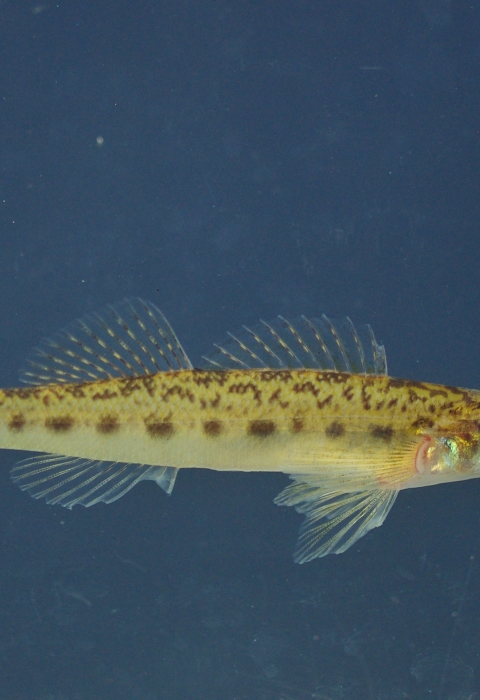Today, the U.S. Fish and Wildlife Service is proposing to designate critical habitat for the pearl darter, a small fish native to the Pascagoula River system of Mississippi and the Pearl River system of Mississippi and Louisiana. Pearl darters continue to survive in the Pascagoula River system but have not been seen in the Pearl River system for more than 40 years.
“The protection of the pearl darter in 2017 under the Endangered Species Act paved the way for us to work together with our conservation partners in Mississippi on recovering the species,” said Leopoldo Miranda-Castro, the Service’s Regional Director. “Designating critical habitat for the darter will not only help us recover this species, but and will help protect important riverine habitats in south Mississippi where other rare species are found.”
Listed as threatened under the Endangered Species Act (ESA) by the Service in October 2017, this small, snub-nosed fish has faced decline from poor water quality and degraded stream and river channels. Nonpoint-source pollution from land-surface and stormwater runoff and point-source pollution, such as wastewater discharged from treatment plants and industrial sites, continue to affect the pearl darter’s habitats. In addition, the pearl darter’s localized distribution, apparent low population numbers, and possibly low genetic diversity make it more vulnerable to catastrophic events such as droughts, storms, and oil or chemical spills.
Plans for the pearl darter’s recovery include reintroduction into the Pearl River drainage. The Service, the University of Southern Mississippi, and the Mississippi Department of Wildlife, Fisheries, and Parks have worked together to regularly monitor for pearl darters and other bottom-dwelling fish in both the Pearl and Pascagoula river systems. Methods and facilities for propagating the species have also been developed, tested, and proven at the Private John Allen National Fish Hatchery in Tupelo, Mississippi.
When a species is listed under the ESA, the Service is required, where possible, to identify areas essential to the conservation of that species, known as critical habitat. When the pearl darter was listed in 2017, critical habitat was not determinable. The Service has worked since then to identify those areas.
The areas proposed as critical habitat for the darter consist of 517 river miles in two separate units in Mississippi within Clarke, Covington, Forrest, George, Greene, Lauderdale, Jackson, Jones, Newton, Perry, Simpson, Stone and Wayne counties. The proposed critical habitat does not include riparian riparian
Definition of riparian habitat or riparian areas.
Learn more about riparian areas, only instream habitat (stream and river channels) within the ordinary high water line.
Unit one, the Pascagoula River Unit, is 487 river miles of occupied critical habitat. Unit two, the Strong River Unit, is 30 river miles of unoccupied critical habitat and is being included to facilitate the reintroduction of the pearl darter into this major tributary of the Pearl River system in Simpson County, Mississippi. Strong River was historically occupied by the species, prior to 1973.
Both proposed units are occupied by other federally listed species like the Gulf sturgeon and its critical habitat, yellow-blotched map turtle, and ringed map turtle. Conservation measures to avoid or minimize impacts to those listed aquatic species will likely be similar to those for avoiding adverse impacts to pearl darter habitat and are not expected to trigger additional requirements under state or local regulations.
Under the ESA, federal agencies must ensure that any action they authorize, fund, or carry out is not likely to result in the destruction or adverse modification of critical habitat. The designation of critical habitat on private land has no impact on individual landowner activities unless they also involve activities by a federal agency or require federal funding or permits. Critical habitat designations do not affect landownership or establish a wildlife refuge, preserve or other conservation area conservation area
A conservation area is a type of national wildlife refuge that consists primarily or entirely of conservation easements on private lands. These conservation easements support private landowner efforts to protect important habitat for fish and wildlife and major migration corridors while helping to keep agricultural lands in production.
Learn more about conservation area , nor does it allow the government or public to access private lands.
Most activities occurring within stream channels such as recreational boating, canoeing, swimming, and fishing do not involve a federal action that may affect critical habitat and, therefore, would not be affected. Private land use activities such as farming and logging that do not involve federal funding or permits will not be affected.
As part of designating critical habitat, the Service takes into account the economic impact, as well as any other relevant impacts, of specifying any particular area as critical habitat. The Service may exclude any area from critical habitat if it is determined that the benefits of excluding it outweigh the benefits of including the area as a part of critical habitat. In addition, the Service is making available for public comment the draft economic analysis of the proposed designation. The draft report found that the economic cost of implementing the rule will likely be limited to additional administrative effort in considering adverse modification of pearl darter habitat during section 7 consultations.
The public is invited to submit comments on both the proposed critical habitat designation and draft economic analysis during a 60-day comment period ending September 13, 2021. For instructions on how to comment, go to the Federal eRulemaking Portal: regulations.gov. In the Search box, enter FWS–R4–ES–2020–0062, which is the docket number for this rulemaking. We will accept comments received or postmarked on or before September 13, 2021. We must receive requests for public hearings, in writing by August 27, 2021.




